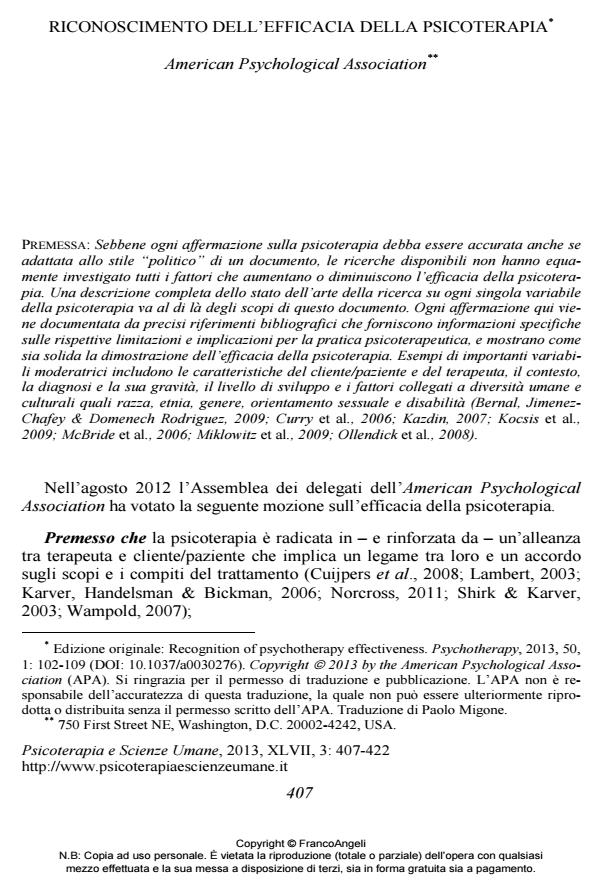Riconoscimento dell’efficacia della psicoterapia
Titolo Rivista PSICOTERAPIA E SCIENZE UMANE
Autori/Curatori
Anno di pubblicazione 2013 Fascicolo 2013/3
Lingua Italiano Numero pagine 16 P. 407-422 Dimensione file 121 KB
DOI 10.3280/PU2013-003001
Il DOI è il codice a barre della proprietà intellettuale: per saperne di più
clicca qui
Qui sotto puoi vedere in anteprima la prima pagina di questo articolo.
Se questo articolo ti interessa, lo puoi acquistare (e scaricare in formato pdf) seguendo le facili indicazioni per acquistare il download credit. Acquista Download Credits per scaricare questo Articolo in formato PDF

FrancoAngeli è membro della Publishers International Linking Association, Inc (PILA)associazione indipendente e non profit per facilitare (attraverso i servizi tecnologici implementati da CrossRef.org) l’accesso degli studiosi ai contenuti digitali nelle pubblicazioni professionali e scientifiche
Nell’agosto 2012 l’Assemblea dei delegati dell’American Psychological Association (APA) ha votato una mozione ufficiale sul riconoscimento dell’efficacia della psicoterapia. Viene fatta una serie di affermazioni (28 in tutto) su vari aspetti della psicoterapia, mostrando che è efficace in diverse condizioni, diagnosi, fasce di età e popolazioni, che è cost-effective e che in alcuni casi è superiore ai farmaci. Ogni affermazione è accompagnata da dettagliati riferimenti bibliografici (circa 150 voci in tutto) che documentano le ricerche controllate che supportano ogni singola affermazione fatta. Nelle conclusioni viene deliberato che l’APA si impegna a informare maggiormente il pubblico sull’efficacia della psicoterapia e a fare pressioni per modificare le politiche sanitarie affinché venga riconosciuto formalmente l’utilizzo della psicoterapia nei servizi di salute mentale, soprattutto per venire incontro ai bisogni degli utenti sottoprivilegiati.
Parole chiave:Efficacia della psicoterapia, American Psychological Association, servizi di salute mentale, ricerca in psicoterapia, cost-effectiveness della psicoterapia
- Psychology profession, clinical psychology, psychotherapy. Specificities and boundaries Gianluca Castelnuovo, Santo Di Nuovo, Vittorio Lingiardi, Fabio Madeddu, Sergio Salvatore, in RIVISTA DI PSICOLOGIA CLINICA 1/2023 pp.7
DOI: 10.3280/rpc1-2023oa16357
, Riconoscimento dell’efficacia della psicoterapia in "PSICOTERAPIA E SCIENZE UMANE" 3/2013, pp 407-422, DOI: 10.3280/PU2013-003001